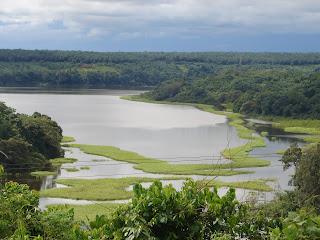Plantations galoreBruno has been a driver for CWCS since the inception of the conservation organisation about ten years ago and knows the Douala reserve area like the back of his palms.
“It will take us about two hours to arrive at Mouanko because the roads are particularly bad at this time of the year”, the polite Bruno cautioned as we steered off the Edea – Douala road through Ekitie on a wide but pothole-packed earth road.
We drove along swinging from left to right and vice versa frequently, trying to avoid the larger potholes. For about ten kilometres, we drove beside the great Sanaga River as it made its way quietly down towards the sea.

As Bruno announced that we were about to hit the small town of Dizangue, I held my breath as he pointed out to my right, the Lake Olsa. From our vantage point from the road above, it was an excellent sight as the lake caved into greenery that stretched beyond the horizon. It all looked as intact as I had imagined. But, I was soon to discover that this was a landscape shimmer on a hot summer day.
The image of the beauty of Lake Olsa and the greenery around it disappeared as soon as we took the next bend. First, we drove past hectares of a rubber plantation and then a forest of palms.
“We will drive through plantations for more than three quarters of the journey”, Bruno told me as if reading my disappointment. “I was told by sages around here that many years ago, this was once a huge forest full of elephants and buffaloes”, the driver continued.

What had become of this wildlife after this vast human destruction? It began to dawn on me why the Douala – Edea Reserve had to be created as early as in 1930. Maybe the reserve should be the last remaining refuge for wildlife as human pressure keep closing in from inland towards the sea, I imagined. We arrived in the small town of Mouanko with this deep feeling of desolation all over me.
Mouanko, the last bastion of hopeThere isn’t much to write home about Mouanko. But for the weary traveller or tourist anxious to discover the hidden treasures of nature in that part of Cameroon, the town is just fine with its two inns, a hospital, schools, a post office, a few small shops, bars and basics like electricity. The river Sanaga curls around the town as if resisting the last descent in to the nearby Atlantic Ocean.

At the centre of town is located the CWCS office where I met the organisations Manager, Ajinoni Gordon. In his modest office adorned with maps, pictures, charts and many other articles depicting the biodiversity of the area, one can tell this manager has been around for quite sometime and means business. So I wasted no time in asking about his area of work and what CWCS was up to. Gordon must have answered this same question from thousands of visitors before, judging from the way he turned on to one of his wall maps to treat me to a succinct presentation of the Douala – Edea reserve.
“This is the meeting point of Cameroon’s largest rivers – this means, the land around here is the reservoir of whatever these great rivers have carried along throughout their long journey from the interior to the sea”, began the project manager, using a ruler to point out the entry points of the said rivers. He pointed at the Wouri, Sanaga, Nyong and the Dibamba.
“This area constitutes one of most important biologically rich protected area within coastal and marine ecosystems”, said Gordon as he gave me the details of the visit we were going to make early the next morning.
Created in 1932 by the colonial administration, the Douala- Edea Reserve covers 160 000hectares of tropical lowland equatorial forest (80%) and Atlantic mangrove forests (15%). The zone is host to a rich fauna of flagship species including forest elephants, primates (chimpanzees, monkey species especially black Columbus), antelopes (sitatunga, blue duiker, etc), west African manatees, sea turtles, dolphins, crocodiles, alligator, many fish species, terrestrial and water bird species.





